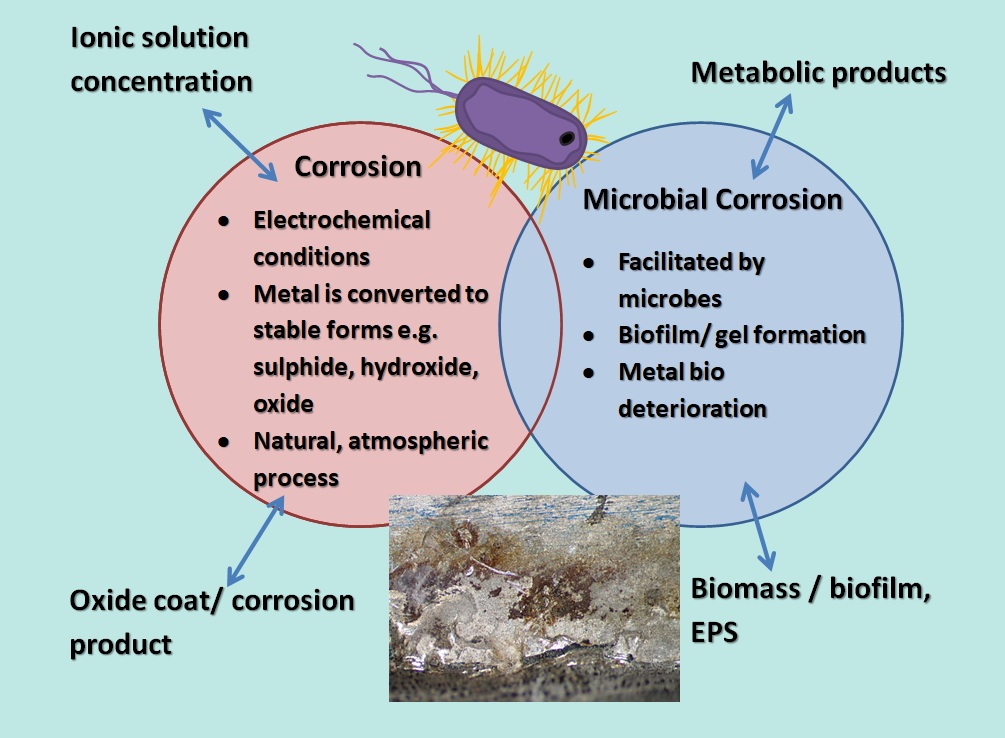Microbial Induced Corrosion - MIC
 Microbial Induced Corrosion MIC is a type of corrosion in which the deterioration of metals is facilitated by the presence and activity of microorganisms. It is estimated that about 10% of all corrosion to metals and non-metals are caused by microbial activity. One significant example of microbial-induced corrosion is the anaerobic corrosion of iron and steel. Microbial corrosion is distinct from electrochemical corrosion which is an anodic reaction involving the ionisation (oxidation) of the metal (the corrosion reaction), and a cathodic reaction based on the reduction of chemical compounds. MIC is almost always associated with biofilm formation. A biofilm can be described as a gel-like substance composed of a mixture of about 95% water, extracellular polymeric substance EPS and a suspension of cells and inorganic matter.
Microbial Induced Corrosion MIC is a type of corrosion in which the deterioration of metals is facilitated by the presence and activity of microorganisms. It is estimated that about 10% of all corrosion to metals and non-metals are caused by microbial activity. One significant example of microbial-induced corrosion is the anaerobic corrosion of iron and steel. Microbial corrosion is distinct from electrochemical corrosion which is an anodic reaction involving the ionisation (oxidation) of the metal (the corrosion reaction), and a cathodic reaction based on the reduction of chemical compounds. MIC is almost always associated with biofilm formation. A biofilm can be described as a gel-like substance composed of a mixture of about 95% water, extracellular polymeric substance EPS and a suspension of cells and inorganic matter.
Microbial corrosion is mostly prevalent in industries with high usage of saltwater, freshwater, or chemicals in their operations. Major industries that are the most impacted include:
- Onshore and offshore oil and gas industries
- Underground pipeline networks for the transport of various products
- Water treatment industry including heat exchangers, piping, stainless steel tanks, flange joints
- Nuclear power generation
- Aviation
- Marine and shipping industry
Four main groups of bacteria are associated with microbial corrosion as follows:
- Sulphate-reducing bacteria: Includes Desulfovibrio spp and Desulfotomaculum.
- Slime-forming bacteria: Includes Clostridium spp, Pseudomonadaceae, Enterobacteriaceae, Micrococcaceae, and Bacillaceae.
- Metal depositing bacteria: Biotransformation of iron and manganese to form their oxide deposits. Includes Siderocapsa, Gallionella, Sphaerotilus, Leptothrix, Crenothrix, Clonothrix, and Hyphomicrobium.
- Sulphur-oxidising bacteria: Includes Thiobacillus, Beggiatoa, Chlorobium, and Chromatium.
Analytical Investigations of Microbial Corrosion
The complexity of MIC reactions means that a broad range of techniques must be employed to relate the corrosion processes to the microbial activities at solid surfaces and in liquid samples supplied by our clients.
- Microscopic Techniques: optical microscopy and SEM provide information about the morphology of microbial cells and colonies, their distribution on the surface, the presence of extracellular polymeric substance EPS and the nature of corrosion products whether they are crystalline or amorphous. Combining SEM with EDX enables elemental identification of biofilms and provides more accurate identification of the bacteria present in the sample.
- Chemical Analysis: Complementary tests like ICP-MS for elemental quantification of inorganic species like copper, iron, manganese. IC can be used to identify weak organic acids and cations like sulphates and nitrates that can promote bacterial activity. GC-FID and GC-MS may be used for the identification of volatile organic compounds in the sample medium.
In addition, our partner labs can provide other technical services to identify the root causes of microbial induced corrosion in a sample:
- Microbial culture involves cultivation of sample on culture media to grow the bacteria present in the sample to prove their presence. Bacteria may be identified by further analysis.
- MALDI-TOF-MS is the application of mass spectrometry (MS) for the rapid identification of bacterial species by the detection of their specific protein mass spectra.
- RNA sequencing is the mapping of the 16S rRNA nucleotide sequences of the bacteria and comparison with published database sequences.

